1998 CADILLAC SEVILLE climate control
[x] Cancel search: climate controlPage 155 of 378
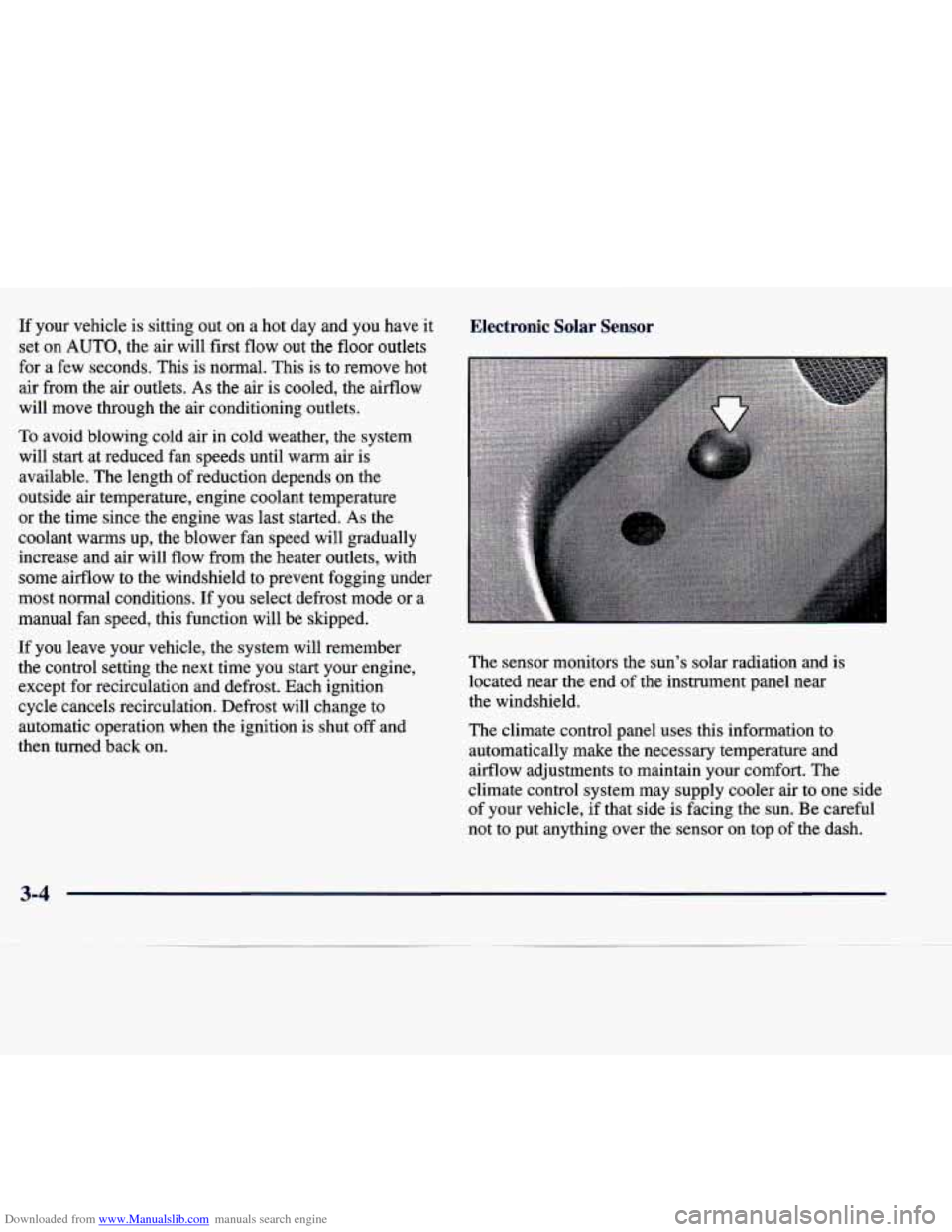
Downloaded from www.Manualslib.com manuals search engine If your vehicle is sitting out on a hot day and you have it
set on
AUTO, the air will first flow out the floor outlets
for a few seconds. This is normal. This is to remove hot
air from the air outlets.
As the air is cooled, the airflow
will move through the air conditioning outlets.
To avoid blowing cold air in cold weather, the system
will start at reduced fan speeds until warm air is
available. The length of reduction depends on the
outside air temperature, engine coolant temperature
or the time since the engine was last started.
As the
coolant warms up, the blower fan speed will gradually
increase and air will flow from the heater outlets, with
some airflow to the windshield to prevent fogging under
most normal conditions. If you select defrost mode or a
manual fan speed, this function will be skipped.
If you leave your vehicle, the system will remember
the control setting the next time you start your engine,
except for recirculation and defrost. Each ignition
cycle cancels recirculation. Defrost will change to
automatic operation when the ignition is shut
off and
then turned back on.
Electronic Solar Sensor Electronic Solar Sensor
The sensor monitors the sun’s solar radiation and is
located near the end of the instrument panel near
the windshield.
The climate control panel uses this information to
automatically make
the necessary temperature and
airflow adjustments to maintain your comfort. The
climate control system may supply cooler air to one side
of your vehicle, if that side is facing the sun. Be careful
not to put anything over the sensor on top
of the dash.
3-4
Page 156 of 378
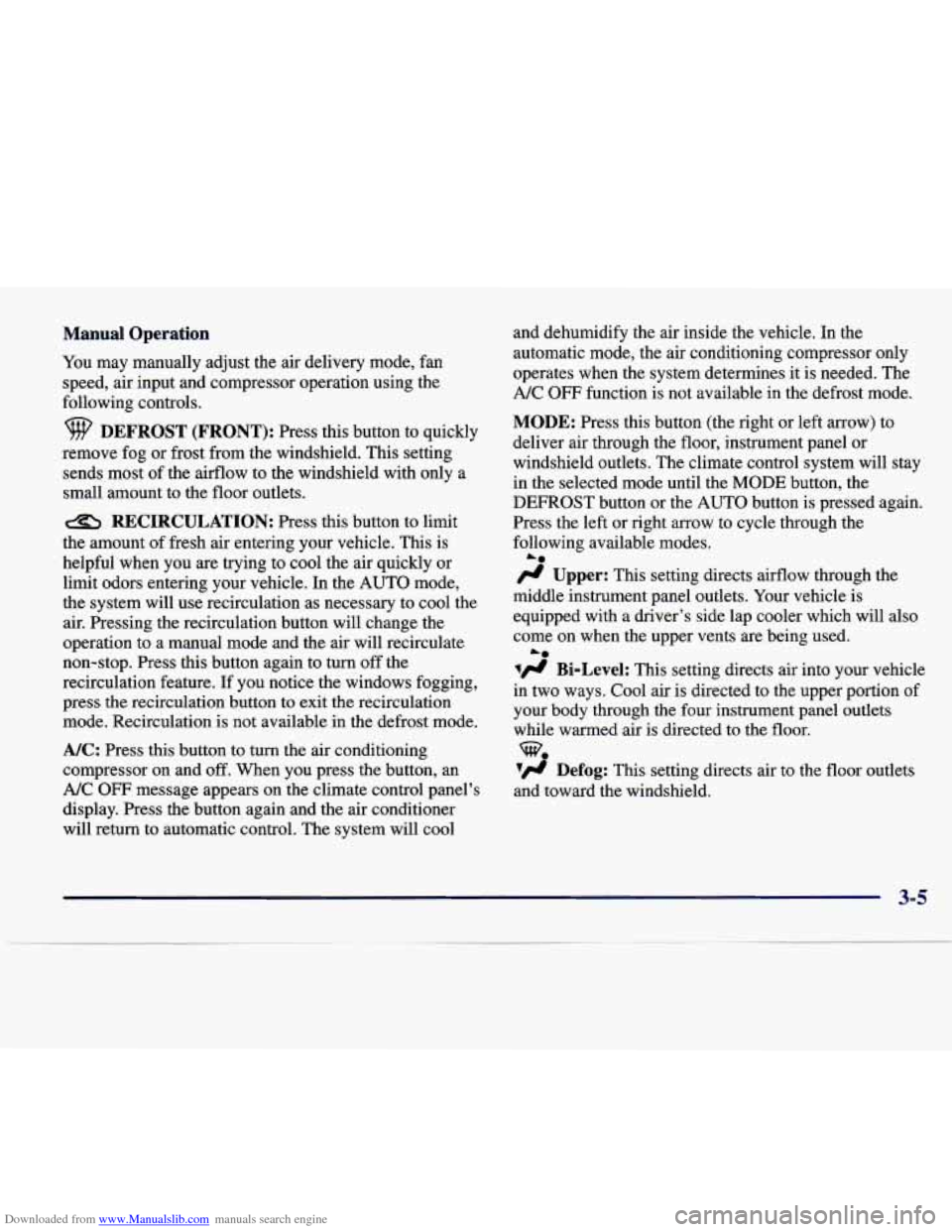
Downloaded from www.Manualslib.com manuals search engine Manual Operation
You may manually adjust the air delivery mode, fan
speed, air input and compressor operation using the
following controls.
DEFROST (FRONT): Press this button to quickly
remove fog or frost from the windshield. This setting
sends most of the airflow to the windshield with only a
small amount to the floor outlets.
RECIRCULATION: Press this button to limit
the amount of fresh air entering your vehicle. This is
helpful when you are trying to cool the air quickly or
limit odors entering your vehicle. In the AUTO mode,
the system will use recirculation as necessary to cool the
air. Pressing the recirculation button will change the
operation to a manual mode and the air will recirculate
non-stop. Press this button again to turn
off the
recirculation feature. If you notice the windows fogging,
press the recirculation button to exit the recirculation
mode. Recirculation is not available in the defrost mode.
NC: Press this button to turn the air conditioning
compressor on and
off. When you press the button, an
A/C OFF message appears on the climate control panel’s
display. Press the button again and the air conditioner
will return to automatic control. The system will cool and dehumidify the air inside
the vehicle. In the
automatic mode, the air conditioning compressor only
operates when the system determines it is needed. The
A/C
OFF function is not available in the defrost mode.
MODE: Press this button (the right or left arrow) to
deliver air through the floor, instrument panel or
windshield outlets. The climate control system will stay
in the selected mode until the MODE button, the
DEFROST button or the AUTO button
is pressed again.
Press the left or right arrow to cycle through the
following available modes.
fl Upper: This setting directs airflow through the
middle instrument panel outlets. Your vehicle is
equipped with a driver’s side lap cooler which will also
come on when the upper vents are being used.
lfl Bi-Level: This setting directs air into your vehicle
in two ways. Cool air is directed to the upper portion of
your body through the four instrument panel outlets
while warmed air is directed to the floor.
7. Defog: This setting directs air to the floor outlets
and toward the windshield.
A*
Le
-e
3-5
Page 157 of 378
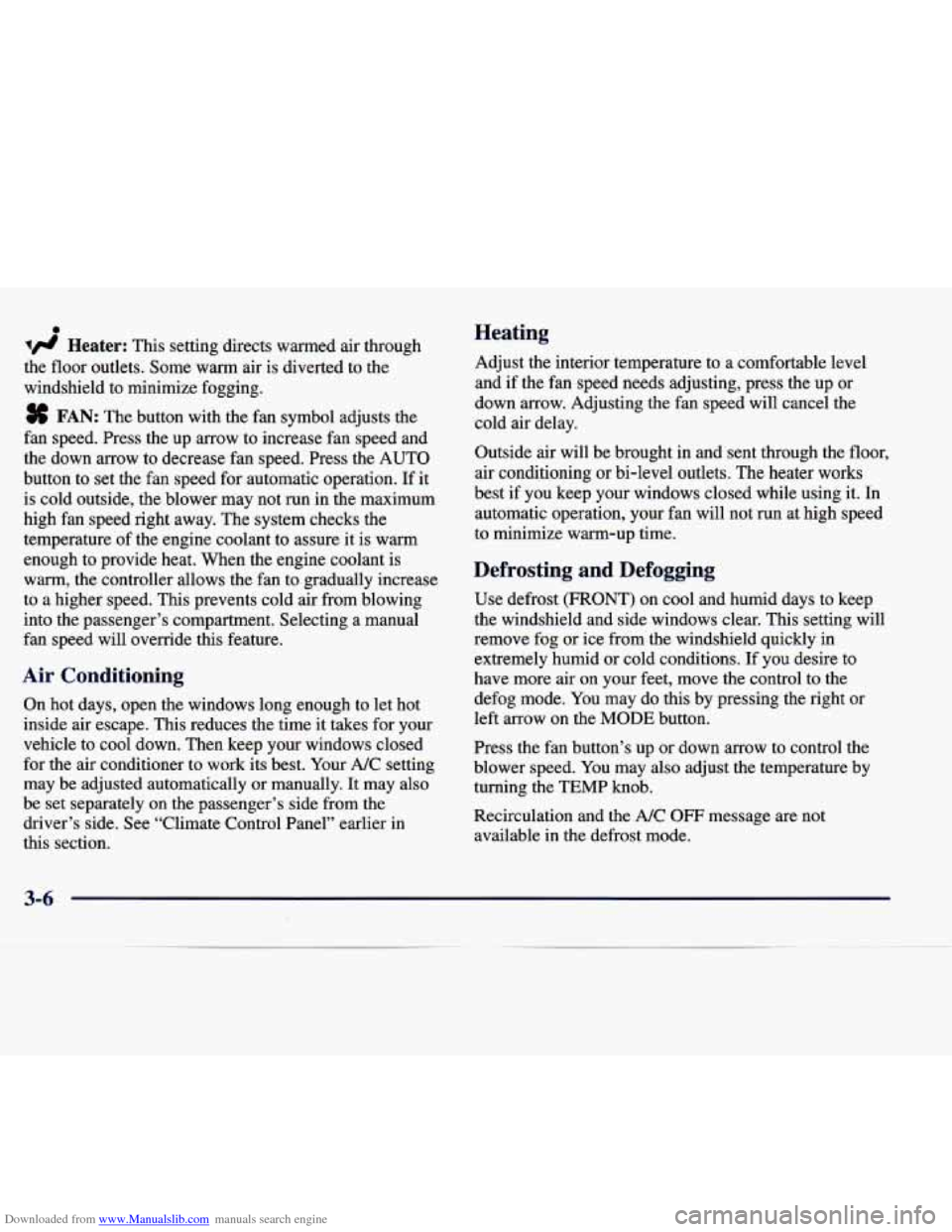
Downloaded from www.Manualslib.com manuals search engine 0
I# Heater: This setting directs warmed air through
the floor outlets. Some warm air is diverted to the
windshield to minimize fogging.
8 FAN: The button with the fan symbol adjusts the
fan speed. Press the up arrow to increase fan speed and
the down arrow to decrease fan speed. Press the AUTO
button to set the fan speed for automatic operation.
If it
is cold outside, the blower may not run in the maximum
high fan speed right away. The system checks the
temperature of the engine coolant to assure it is warm
enough to provide heat. When the engine coolant is
warm, the controller allows the fan to gradually increase
to a higher speed. This prevents cold air from blowing
into the passenger’s compartment. Selecting a manual
fan speed will override this feature.
Air Conditioning
On hot days, open the windows long enough to let hot
inside air escape. This reduces the time it takes for your
vehicle to cool down. Then keep your windows closed
for the air conditioner to work its best. Your A/C setting
may be adjusted automatically or manually.
It may also
be set separately on the passenger’s side from the
driver’s side. See “Climate Control Panel” earlier in
this section.
Heating
Adjust the interior temperature to a comfortable level
and if the fan speed needs adjusting, press the up or
down arrow. Adjusting the fan speed will cancel the
cold air delay.
Outside air will be brought in and sent through the floor,
air conditioning or bi-level outlets. The heater works
best if you keep your windows closed while using it. In
automatic operation, your fan will not run at high speed
to minimize warm-up time.
Defrosting and Defogging
Use defrost (FRONT) on cool and humid days to keep
the windshield and side windows clear. This setting will
remove fog or ice from the windshield quickly in extremely humid or cold conditions. If you desire to
have more air on your feet, move the control to the
defog mode. You may do this by pressing the right or
left arrow on the
MODE button.
Press the fan button’s up or down arrow to control the
blower speed. You may
also adjust the temperature by
turning the TEMP
knob.
Recirculation and the A/C OFF message are not
available in the defrost mode.
3-6
.
Page 161 of 378
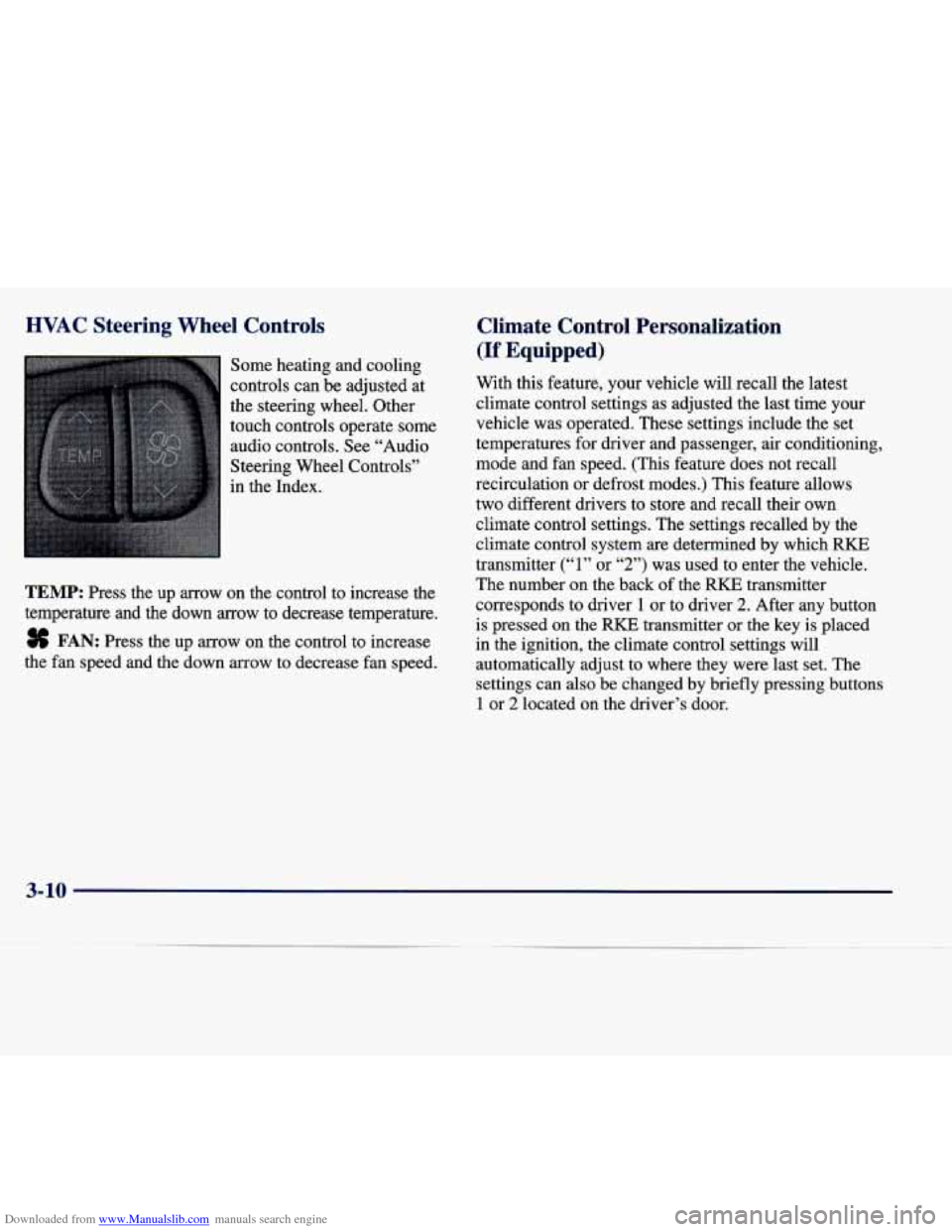
Downloaded from www.Manualslib.com manuals search engine HVAC Steering Wheel Controls
Some heating and cooling
controls can be adjusted at
the steering wheel. Other
touch controls operate some
audio controls. See “Audio
Steering Wheel Controls”
in the Index.
TEMP: Press the up arrow on the control to increase the
temperature and the down
arrow to decrease temperature.
8 FAN: Press the up arrow on the control to increase
the fan speed and the down arrow to decrease fan speed.
Climate Control Personalization
(If Equipped)
With this feature, your vehicle will recall the latest
climate control settings as adjusted the last time your
vehicle was operated. These settings include the set
temperatures for driver and passenger, air conditioning,
mode and fan speed. (This feature does not recall
recirculation
or defrost modes.) This feature allows
two different drivers to store and recall their own
climate control settings. The settings recalled by the
climate control system
are determined by which RKE
transmitter
(“1” or “2”) was used to enter the vehicle.
The number on the back
of the RKE transmitter
corresponds to driver
1 or to driver 2. After any button
is pressed on the
RKE transmitter or the key is placed
in the ignition, the climate control settings will
automatically adjust to where they were last set. The
settings can also be changed by briefly pressing buttons
1 or 2 located on the driver’s door.
3-10
Page 322 of 378
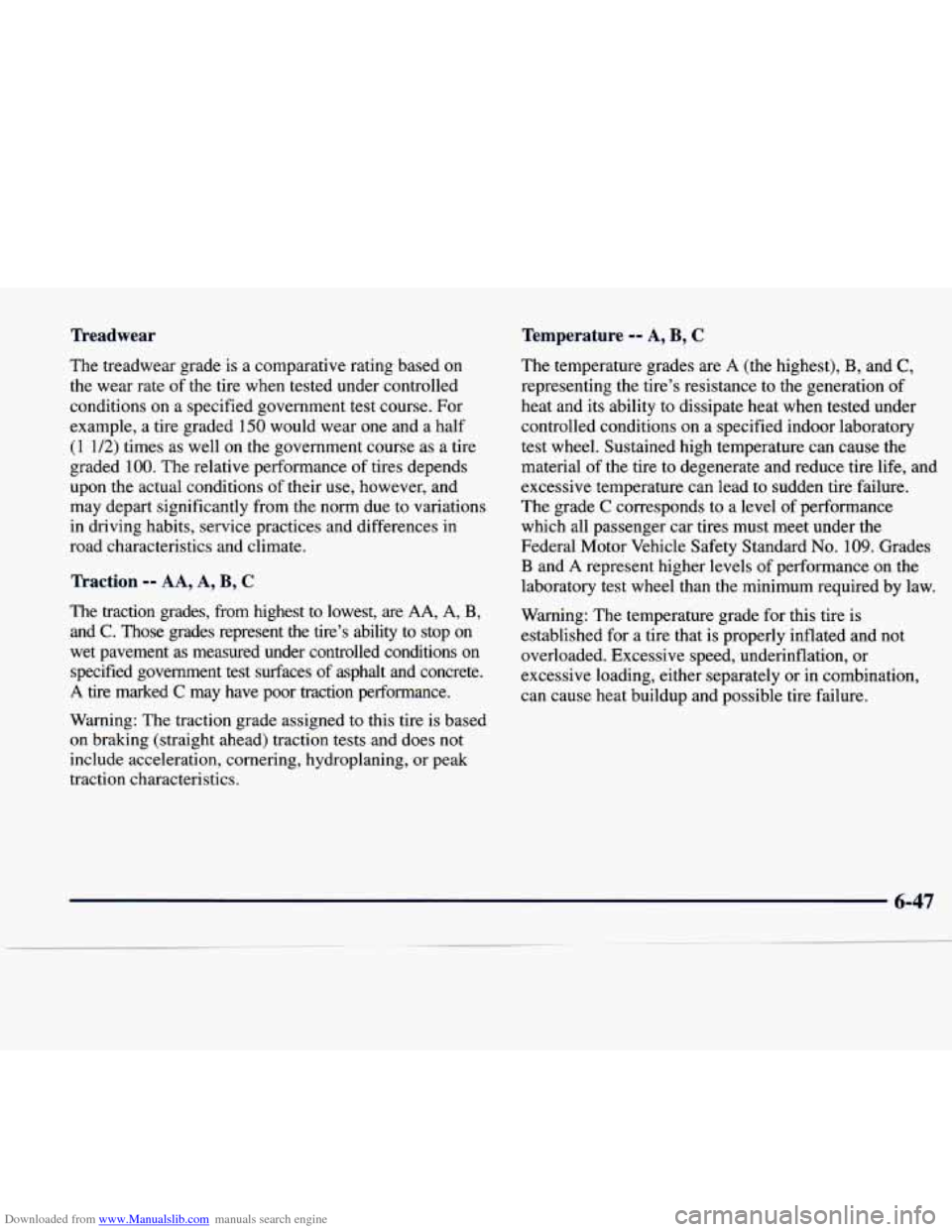
Downloaded from www.Manualslib.com manuals search engine Treadwear Temperature -- A, B, C
The treadwear grade is a comparative rating based on
the wear rate of the tire when tested under controlled
conditions
on a specified government test course. For
example, a tire graded 150 would wear one and a half
(1 1/2) times as well on the government course as a tire
graded
100. The relative performance of tires depends
upon the actual conditions
of their use, however, and
may depart significantly from the norm due to variations
in driving habits, service practices and differences in
road characteristics and climate.
Traction -- AA, A, B, C
The traction grades, from highest to lowest, are AA, A, B,
and C. Those grades represent the tire’s ability to stop on
wet pavement as measured under controlled conditions on
specified government test surfaces
of asphalt and concrete.
A tire marked C may have poor traction performance.
Warning: The traction grade assigned to this tire is based
on braking (straight ahead) traction tests and does not
include acceleration, cornering, hydroplaning, or peak
traction characteristics. The
temperature grades are
A (the highest), B, and C,
representing the tire’s resistance to the generation of
heat and
its ability to dissipate heat when tested under
controlled conditions on
a specified indoor laboratory
test wheel. Sustained high temperature can
cause the
material of the tire to degenerate and reduce tire life, and
excessive temperature can lead to sudden tire failure.
The grade
C corresponds to a level of performance
which all passenger car tires must meet under the
Federal Motor Vehicle Safety Standard
No. 109. Grades
B and A represent higher levels of performance on the
laboratory test wheel than the minimum required by law.
Warning: The temperature grade for this tire is
established for a tire that is properly inflated and not
overloaded. Excessive speed, underinflation, or
excessive loading, either separately or in combination,
can cause heat buildup and possible tire failure.
Page 362 of 378

Downloaded from www.Manualslib.com manuals search engine ..
Section 8 Index
ABS ......................................... 4.7
Adaptive Seat Control
............................ 1-3
AirBag ....................................... 1-19
How Does it Restrain .......................... 1-25
How it Works ................................ 1-22
Location
.................................... 1-22
Readiness Light
......................... 1-22. 2-65
Servicing
................................... 1-27
What Makes it Inflate
.......................... 1-25
What Will You See After it Inflates
............... 1-25
When Should it Inflate
......................... 1-24
Aircleaner
.................................... 6-16
Air Conditioning
................................ 3-6
Air Conditioning Refrigerants
..................... 6-68
Air Control. Climate Control Panel
.................. 3-2
Air Filter. Passenger Compartment
.................. 3-9
Alarm. Theft-Deterrent
.......................... 2- 14
Alignment and Balance. Tire
...................... 6-48
Aluminum Wheels. Cleaning
...................... 6-55
Antenna. Diversity .............................. 3-45
Antifreeze
..................................... 6-22
Anti-Lock Brake System Warning Light
................ 2-68. 4-7
Brakes ...................................... 4-7
Anti-Lockout Feature
............................ 2-6
Anti-Theft. Radio .............................. 3-42
Adding Equipment
to the Outside
of Your Vehicle ...... 6-3 Appearance Care
............................... 6-50
Appearance Care Materials ....................... 6-57
Arbitration Program
............................. 7-11
Armrest. Storage
............................... 2-52
Ashtrays
...................................... 2-53
Assist Straps
................................... 2-54
Audio Equipment. Adding
........................ 3-43
Audio Steering Wheel Controls
.................... 3-42
Audio Systems
................................. 3-11
Automatic Door Locks
............................ 2-5
Automatic Overdrive
............................ 2-23
Automatic Transaxle
Operation
................................... 2-21
Shifting
..................................... 2-21
Starting Your Engine
.......................... 2-19
Fluid
....................................... 6-19
Battery ...................................... 6-32
Jump Starting
................................. 5-3
Not Charging Message ......................... 2-82
Saver Active Message
......................... 2-82
Voltage
Low Message ......................... 2-83
Warnings
................................ 5-3. 5-5
Charging System Indicator Light ................. 2-66
Replacement. Remote Keyless Entry ............... 2-9
Voltage High Message
......................... 2-83
8-1
Page 364 of 378

Downloaded from www.Manualslib.com manuals search engine Cleaning Aluminum or Chrome Wheels
................... 6-55
Fabric
...................................... 6-51
Glass
....................................... 6-53
Inside of Your Vehicle
......................... 6-50
Instrument Panel
............................. 6-52
Leather
..................................... 6-52
Outside of Your Vehicle
........................ 6-54
Speakercovers
.............................. 6-52
Special Problems
............................. 6-5 1
Stains ...................................... 6-5 1
Tires
....................................... 6-55
Vinyl
....................................... 6-52
Wheels
..................................... 6-55
Windshield and Wiper Blades
................... 6-53
WoodPanels
................................. 6-52
Climate Control Panel
............................ 3-2
Climate Control Personalization
................... 3- 10
Climate Control. Steering Wheel Controls ........... 3-10
Clock. Setting the ............................... 3- 11
Comfort Controls ................................ 3-2
Compact Disc Care
............................. 3-45
Compact Disc Player
....................... 3-1 1. 3-20
Compact Disc Player Care
........................ 3-45
Compact Disc Player Errors
.................. 3-15. 3-28
Compact Spare Tire
............................. 5-35
Compass. Rearview Mirror with
................... 2-47
Console Shift Lever
............................. 2-27
Console-Mounted CD Changer
.................... 3-39
Continuous Variable Road Sensing Suspension
........ 2-75
Control Buttons
................................ 2-80
Control of a Vehicle
.............................. 4-6
ConvenienceNet
............................... 2-52
Convex Outside Mirror
.......................... 2-50 Coolant
....................................... 6-22
CheckMessage
.............................. 2-83
Heater. Engine
............................... 2-20
SurgeTank
.................................. 5-20
Cooling System
................................ 5-18
Cornering Lamps
............................... 2-42
Cruise Control
................................. 2-36
Cupholders
.................................... 2-52
Curbview Assist Mirror
..................... 2.51. 2.79
Customer Assistance Information
................... 7-1
Customer Satisfaction Procedure
.................... 7-2
CVRSS
....................................... 2-75
Customer Assistance for
Text Telephone Users
......... 7-4
Damage. Finish
............................... 6-56
Damage. Sheet Metal
............................ 6-56
Daytime Running Lamps
......................... 2-41
Dead Battery
................................... 5-3
Defects. Reporting Safety
................... 7.12. 7.13
Defensive Driving
............................... 4-2
Defogger. Rear Window
.......................... 3-7
Defrosting
..................................... 3-6
DIC
.......................................... 2-75
Dimensions. Vehicle
............................ 6-66
Diversity Antenna
.............................. 3-45
Dolby Noise Reduction
........... 3.14.3.19.3.28. 3.37
Door Defogging
..................................... 3-6
Central Unlocking System
....................... 2-4
Locks
........................................ 2-4
MapPocket
................................. 2-51
OpenMessage
............................... 2-84
Driver Information Center
........................ 2-75
8-3